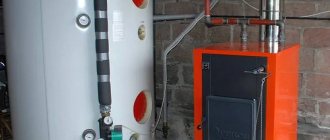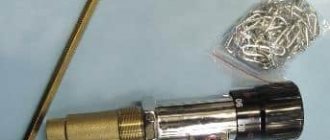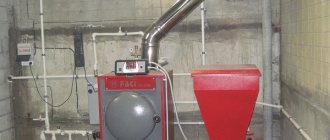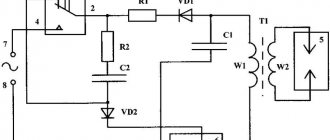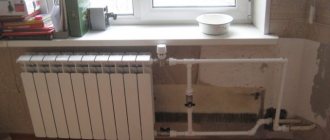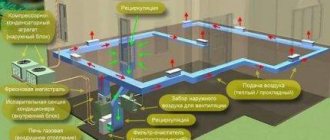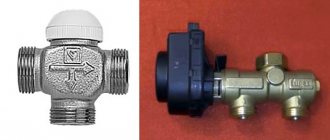Installing a special device for controlling the heating level of an autonomous heating system in a private home reduces fuel consumption by 20%, reduces the load on equipment and increases indoor comfort. Let's look at what a thermostat for a heating boiler is, how it works and what it is intended for, what types of it exist, how to choose the right one for specific application conditions and what are the features of its connection.
Digital room thermostat for heating boiler Source gradusplus.com
Thermostat - what is it, purpose, principle of operation
The thermoregulatory device interacts between the heating heater and the temperature of the atmosphere indoors and outdoors, as well as the level of heating of the coolant, pipes and radiators. In this case, the parameters are set by the user through the control unit.
A typical thermostat consists of the following set of main components:
- Thermosensitive sensor. It is made of a material that changes characteristics under the influence of changes in ambient temperature. The signal from the sensor is transmitted to the control unit.
- Control module. It detects the slightest changes in sensor parameters and issues the appropriate command to the operating mechanism, which directly triggers one or another action in the boiler equipment. This can be a simple mechanical valve or an electromagnetic relay, as well as a digital or analog device.
A temperature-sensitive element connected by a wire to the actuator unit Source par-torg.com
- Settings block. On it, the user sets the temperature values and other parameters at which the thermostat for the heating boiler should operate. In mechanical models, one single setting is performed, in electronic models, several parameters are set simultaneously.
The device operates according to the following algorithm:
- Using the settings block, the user sets the required temperature value.
- As soon as the heating level of the medium reaches the desired value, the control module detects the changes that have occurred in the characteristics of the sensor.
- Next, a signal is sent to the operating mechanism to perform a specific action - stopping the boiler, closing the pipeline valve, shutting off the radiator, etc.
- As the ambient temperature reaches below the set value, the control unit again records the changes in the sensor and starts the system to increase the temperature.
Advice! During the absence of the owners or during night sleep, using a programmable thermostat, you can lower the temperature in the house by 3-4 0C below the normal value. This will reduce energy consumption by 30% compared to the usual consumption rate.
The thermostat ensures a comfortable microclimate in the house no matter the weather surprises Source stroy-podskazka.ru
Advantages of wireless thermostats
The room thermostat in the gas boiler circuit accurately regulates the temperature and reduces energy consumption. In addition, it works in automatic mode - there is no need for manual settings.
Using a programmer relieves the user of problems with maintaining the microclimate in a house or apartment, opening up the following opportunities:
- Accurate and fast temperature control. The exhibition accuracy is 0.3 degrees.
- Day-night modes, functions for setting temperatures by time intervals several days in advance.
- Connecting a GSM module or control system via Wi-Fi further reduces the need for human participation in controlling the boiler.
- Regulation of air temperature in different rooms.
- Economical operation of gas equipment. The thermostat costs money, but pays for itself by reducing overall heating costs, including electricity, by 20-25%. The fact is that when the boiler is turned off, the automation turns off the pump, which is its consumer.
Remote thermostat control
Payback is achieved within just two seasons of operation. Reducing the number of starts/shutdowns leads to saving the life of the gas boiler, the cost of which exceeds the price of additional equipment. Programmable devices regulate the response threshold of the temperature sensor. And the use changes the delay time for turning on/off the gas boiler, which minimizes the likelihood of the automation triggering during short-term temperature fluctuations, for example due to a draft.
A modern wireless thermostat with an ergonomic design, it easily fits into any interior design. Installation does not require wiring, which is convenient when designing a system in old houses.
The only drawback is that the thermostat and boiler work together efficiently, often if they are made by the same manufacturer. Differences in electronics sometimes make devices from different manufacturers incompatible.
Varieties
Household temperature sensors for heating boilers are classified according to several criteria:
- Method of temperature control – mechanical, electromechanical, electronic.
- Boiler type – for electric, gas, solid fuel.
- Installation location - indoor, outdoor.
- Signal transmission method - wired, wireless.
- Number of functions – with one, many (programmable).
Let's look at the features of each variety in more detail.
By temperature control method
Depending on the method by which transformations of the properties of a temperature-sensitive component are transmitted in response to changes in ambient temperature, temperature sensors are divided into the following 3 types:
- Mechanical.
The operating principle of sensors of this type is based on changes in the physical properties of substances under the influence of heating or cooling - namely:
- Expansion-compression of gas or liquid.
- Fluctuations in metal elasticity parameters.
The design of a simple mechanical thermostat Source otoplenie-gid.ru
The design of devices with liquid or gaseous substances is based on a sealed flask. When the heating level changes, the liquid or gas contracts or expands, thereby moving the valve stem or gate. The operation of models based on a metal element is based on the closing and opening of contacts. When heating and cooling, the plate is deformed - supplying or interrupting an electrical signal to the control module.
The main advantages of a mechanical temperature controller for a heating boiler:
- Independence from the state of the external power supply network.
- Simple device and simple design.
- Low cost.
The negative aspects of this type of regulator are expressed in low sensitivity, a fairly noticeable error - up to 20C and bulkiness. Most often they are installed to control the temperature of the coolant in the radiator, but not the air in the room.
To set up a mechanical thermostat, just turn the knob to the desired position Source terman-s.ru
- Electromechanical. The operating principle of this type of regulator is based on the occurrence of a potential difference between interconnected plate elements made of different metals. The signal from them passes to an electromagnetic relay to execute a specific equipment command. Due to low sensitivity, high surface heating is required to obtain a sufficient electrical impulse.
Therefore, their main area of application is flame control in the furnace of a boiler operating on direct combustion of fuel. As soon as the fire goes out, a signal instantly passes to the control unit and security system. At the same time, the device requires constant power supply to operate.
- Electronic. Temperature regulators that require a constant power supply for full operation. They contain an external temperature-sensitive element for monitoring air temperature and a control module. As a rule, electric boilers are equipped with them.
The electronic boiler temperature sensor includes 2 main components:
- Thermosensitive element.
- Microcontroller.
Wireless digital thermostat of two modules Source teplo25.ru
See also: Catalog of companies that specialize in engineering systems (heating, water supply, sewerage and others) and related work
Having received a signal from the sensor, the microcontrolling module executes one or more commands programmed into it. In this case, both elements may not necessarily be located in the same housing, but are separated from each other in space. Communication between them is carried out both wired and wireless.
Depending on the type of technology used, there are two types of electronic sensor:
- Analog. Works according to a strict logical algorithm. The capabilities are similar to mechanical models, but more accurate - the error is no more than 0.5 °C.
- Digital. It operates in both closed and open logic circuits. In the latter case, it allows you to make custom settings and set heating parameters according to a schedule.
Advantages of an electronic sensor:
- Connection of remote sensors, including street ones.
- Highly precise settings.
- Variety of execution options.
Disadvantages: energy dependence and high price.
The electronic temperature sensor is quite accurate, but requires constant power supply Source teploregulyator.ru
On a note! Modern models of electronic sensors can be controlled remotely via a mobile application when connected to a smart home system. For example, you can set the desired level of room heating after a long absence when returning home from work, a trip, or vacation.
By boiler type
Despite the fact that all types of heating boilers are designed for one common purpose - heating rooms, they operate, and therefore are controlled, according to slightly different schemes. Therefore, different thermostats are used for them, having the following features:
- For gas. The thermostat for a gas boiler, as a rule, has a built-in design and is designed to control the temperature of the coolant. However, copies of some lines have the ability to connect external sensors to measure the heating of the surrounding air. The influence of a particular sensor on the operation of the unit is set by the control module depending on the settings.
A modern gas boiler with a built-in thermostat to control the temperature of the coolant Source vaillant.ru
In addition, it is possible to connect an external thermostat in parallel with the built-in one - without a special interface according to the following algorithm:
- The executive module is integrated into the electrical power supply circuit of the unit.
- After this, the required room temperature is set on the sensor.
- When the air temperature reaches the set value, the executive unit will de-energize the boiler.
- As it cools, the thermostat will start the burner.
Gas units in non-volatile design are always equipped with mechanical temperature sensors of the remote type. They only control the operation of the burner. Some models may be equipped with a standard external sensor without the possibility of replacement or addition.
- For electric ones.
Unlike the type of unit described above, the electric boiler is controlled in a large number of ways:
- By disconnecting the power supply.
- Changing the intensity of operation of electric heating elements.
- Impact on the controller.
External thermostat for an electric boiler Source onlinetrade.ru
Setting procedure
To configure the system and select a comfortable temperature, follow these steps:
- Set the maximum temperature using the remote controller.
- Start the boiler and bring it to the optimal operating mode, in which the unit achieves the greatest efficiency.
- When all rooms are at a comfortable temperature, take an electronic thermometer and measure the temperature near your regulator.
- Select the measured value on the thermostat as the heater shutdown threshold. Enter the required settings into the programmer.
Important clarification. The gas boiler operates with maximum efficiency at a temperature range of 80/60 °C (supply/return).
Let us explain the purpose of these manipulations. Due to different areas and heat losses, the temperature in the rooms may differ by 1-3 degrees, so it is better to navigate by the degree of heating of the air near the sensor itself.
If the temperature at the point where the regulator is installed is very different from other rooms, when setting, you need to make an adjustment for the magnitude of this difference. Some models, for example, Baxi Magic Plus, provide a function for such adjustment (called temperature shift). Then all that remains is to enter the desired value into the device’s memory, ranging from 1 to 5 degrees.
Video description
Video example of installing and using a smart thermostat for a boiler:
Helpful information! The thermostat should be mounted in a place to prevent it from being exposed to nearby heating devices, sunlight, drafts, cold bridges, electrical equipment, at a height of about 1-1.5 m from the floor surface.
By signal transmission method
Medium heating meters for a heating unit are divided into 2 types according to the method of data transmission:
- Wired. Connect to the controller via cable.
- Wireless. Data transmission is carried out via a radio channel, and goes from the unit that controls the parameters of the room, that is, the temperature sensor itself, to the receiver unit installed near or on the body of the unit.
Helpful information! In addition to room air heating regulators, there are temperature sensors for measuring the heating level of the coolant used in the heating system. They are produced in overhead and submersible versions. The first ones are installed on the surface of the pipeline and batteries, the second ones are mounted in a special place inside the pipes, and during operation they come into direct contact with the heated liquid medium.
We achieve maximum stability and comfort
An additional feature of many electronic thermostats is the ability to organize weather-dependent control, when the boiler power is adjusted, including changes in the outside temperature. To do this, just connect a universal outdoor temperature sensor to the thermostat (2-2.5 thousand rubles).
External temperature sensor for Gira thermostat 130200.
It consists of a single structure: a sensor and a wire 2-6 m long. Therefore, it is enough just to fix the wire strands in the corresponding contacts of the thermostat, according to the instructions.
Selection rules
When choosing a temperature sensor for a heating boiler, the following installation parameters are taken into account:
- How, where and in what way the regulator will be installed.
- Maximum permissible dimensions.
- Operating range of control and regulation of temperature indicators.
- Sensitivity limit.
- Intended purpose for installation - outdoor, indoor, overhead or submersible.
- Basic and additional functionality.
- Control options – via panel, remote control, remotely.
Programmable room thermostat
A programmable electronic room thermostat allows you to select the desired and comfortable temperature at any time; it is easy to reconfigure and change the operating mode. The timer allows you to set a different heating pattern on weekdays and weekends. Some timers allow you to set different settings for each day of the week, which can be useful for people who work part-time or shift work. Many Terneo and KChM models are equipped with such thermostats.
Programmable room thermostat
A programmable room thermostat allows you to set individual heating standards for each day in accordance with your lifestyle and maintain the temperature of the house all the time, regardless of the presence or departure of the owners. Video: Connecting a room thermostat to a gas boiler
If the heating system is controlled by a boiler with a radiator, as a rule, only one programmable room thermostat is needed to control the entire house. Some patterns need to be adjusted in the spring and fall as the clocks move forward and backward or certain changes in climatic conditions occur. We also recommend changing the temperature settings when changing from day to night.
This climate controller has several options that expand its capabilities:
- “Party”, which stops heating for several hours, then resumes;
- “Override” allows you to temporarily change the programmed temperatures during one of the configured periods;
- “Holiday” increases the heating intensity or reduces it for a certain number of days.
Connection features
There are 3 standard schemes for connecting a temperature sensor to a heating boiler - these are:
- Directly to the boiler.
- To the pump.
- In front of the radiator on the pipe.
The first two options do not reduce the power of the coolant flow, unlike the third. In the latter case, the thermostatic valve somewhat impedes the flow, thereby increasing the hydraulic resistance in the system. This must be taken into account - since the pipes are designed for a certain maximum pressure.
To avoid an accident, it is necessary in advance - even at the design stage - to include in the circuit all thermostats mounted on pipes and radiators. In addition, it is recommended to install a temperature sensor in front of the battery using a bypass. With its help, the flow will be redirected to the return line while not cooled down - thereby saving energy resources.
Homemade external thermostat for the boiler: instructions
Below is a diagram of a homemade thermostat for a boiler, which is assembled using Atmega-8 and 566 series microcircuits, a liquid crystal display, a photocell and several temperature sensors. The Atmega-8 programmable microcircuit is responsible for compliance with the specified parameters of the thermostat settings.
Scheme of a homemade external thermostat for a boiler
Strictly speaking, this circuit turns the heating boiler on or off when the outside air temperature decreases (increases) (sensor U2), and also performs these actions when the temperature in the room changes (sensor U1). It is possible to adjust the operation of two timers, which allow you to adjust the time of these processes. A piece of circuitry with a photoresistor affects the process of turning on the boiler depending on the time of day.
Sensor U1 is located directly in the room, and sensor U2 is located on the street. It is connected to the boiler and installed next to it. If necessary, you can add an electrical part of the circuit that allows you to turn on and off high-power units:
The electrical part of the circuit allows you to turn on and off high-power units
Another thermostat circuit with one control parameter based on the K561LA7 chip:
Thermostat circuit with one control parameter based on the K561LA7 microcircuit
The thermostat is assembled on the basis of the K651LA7 microcircuit and is simple and easy to adjust. Our thermostat is a special thermistor that significantly reduces resistance when heating. This resistor is connected to the electricity voltage divider network. This circuit also contains resistor R2, with which we can set the required temperature. Based on this scheme, you can make a thermostat for any boiler: Baxi, Ariston, Evp, Don.
Another circuit for a microcontroller-based thermostat:
Circuit diagram for a thermostat based on a microcontroller
The device is assembled on the basis of a PIC16F84A microcontroller. The role of the sensor is performed by a digital thermometer DS18B20. A small relay controls the load. Microswitches set the temperature, which is displayed on the indicators. Before assembly, you will need to program the microcontroller. First, erase everything from the chip and then reprogram it, and then reassemble it and use it to your health. The device is not capricious and works fine.
The cost of parts is 300-400 rubles. A similar regulator model costs five times more.
A few final tips:
- although different thermostat options are suitable for most models, it is still desirable that the thermostat for the boiler and the boiler itself be made by the same manufacturer, this will greatly simplify the installation and operation process itself;
- before purchasing such equipment, you need to calculate the area of the room and the required temperature in order to avoid “downtime” of equipment and changes in wiring due to connecting devices of higher power;
- before installing the equipment, you need to take care of the thermal insulation of the room, otherwise high heat losses will be inevitable, and this is an additional cost item;
- if you are not sure that you need to purchase expensive equipment, then you can conduct a consumer experiment. Buy a cheaper mechanical thermostat, adjust it and see the result.
Briefly about the main thing
The thermostat controls the operation of the heating unit in accordance with the user’s settings - based on the air temperature indoors and outdoors, as well as the heating level of the radiators and coolant in the system. Its design includes a temperature-sensitive element, a control module and a settings unit.
As soon as the temperature of the controlled environment reaches the set value, the executive unit sends a command to the equipment - turning off the boiler or pump, closing the valve in the pipe. As it cools down, the reverse command is triggered - the equipment turns on for heating.
Modern models of temperature sensors for heating are classified according to the following criteria:
- Thermal control method.
- I see the boiler.
- Installation location.
- Data transfer method.
- Number of functions.
When choosing a regulator for specific application conditions, first of all, its own technical characteristics and their compatibility with the equipment are taken into account. Installation of devices is carried out in three ways - to the boiler, to the pump and to the pipes. Moreover, their introduction into the scheme should occur at the stage of project creation.
How to properly install a thermostat for a gas heating boiler: connection diagram
It is necessary to install a room-type device in the most frequently visited room. As a rule, this is a bedroom or living room. It is important that this is a living room, and not a kitchen, corridor or bathroom. If there are few people in the house, then the coldest room is chosen.
Attention! Before installing a thermostat, take care of insulating the premises. Otherwise, no savings will be achieved due to high heat losses.
When purchasing a wireless electronic thermostat for a gas boiler, you must remember that it requires a constant flow of air. Therefore, it should not be placed behind furniture or covered with curtains. It must also be placed at a safe distance from electrical and heating appliances that interfere with radio waves. Touch switches and neighbors' boilers, which are located through the wall, also pose a danger. Also not suitable are places where the sun's rays fall or there are drafts or air flows from the air conditioner. If there are valves with thermal heads on the heating radiators in the room, there is no point in installing the device here either.
The device is placed at a distance of one and a half meters above the floor. Considering that warm air rises and cold air falls, at this distance the air has an average temperature in the room. This rule must be followed even if floor heating is installed. The device is attached to the internal wall of the building, since the external ones are too cold, even if thermal insulation is installed on them.
The connection diagram for the thermostat to the boiler is indicated in the instructions for the device, but it is worth identifying the key installation requirements. Before starting work, you should always turn off the power supply to the house to protect yourself.
Select the installation location in accordance with the recommendations described above. Connect phase and zero to it, then mount the thermostat. Now you need to connect the phase, neutral and ground of the device with the corresponding contacts of the gas boiler. If the device uses standard markings, the contacts are designated N, L and PE respectively. After connecting them, the connection of the thermostat to the boiler is completed.
How to connect a thermostat to a gas boiler - watch the video instructions



